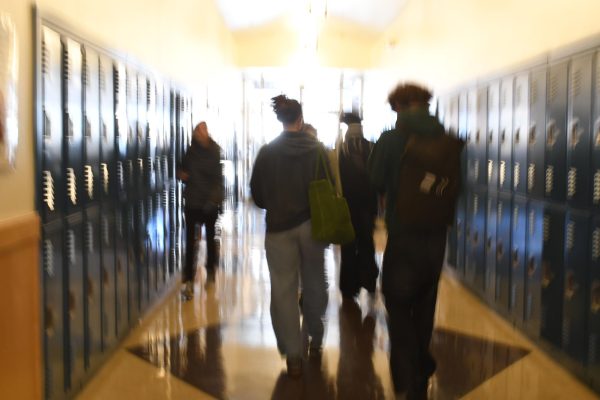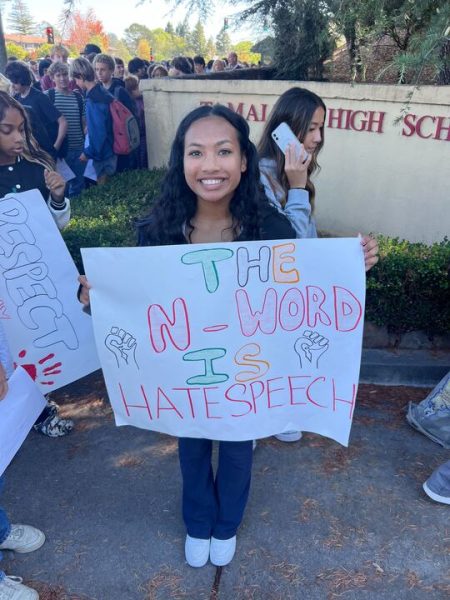Note on content: this article describes the myriad of events and instances that have taken place within our community that have inflicted harm on Black community members. Reader discretion is advised.
The issue of systemic racism Tamalpais High School has carried on for decades, specifically towards Black students, becomes unveiled by Tam students.

By definition, racism is: “prejudice, discrimination, or antagonism by an individual, community, or institution against a person or people on the basis of their membership in a particular racial or ethnic group, typically one that is a minority or marginalized,” according to Oxford Languages.
Its reality is that institutionalized and systemic racism is steadily built through collective community actions, resulting in an unbalanced environment amongst people of different races, creating feelings of hurt, anger, and deteriorating the social cohesiveness many communities strive for.
The Tamalpais Union High School District Board of Trustees approved Resolution 20-1 on Sept. 8, 2020, committing the district to recognize institutional racism in its system and to “eliminat[e] systematic disparities and ensur[e] systemic equality.”
The resolution has further committed to auditing courses and disrupting symbols of racism.
This came after decades of evidence of racist and discriminatory practices, such as graffiti on campus and defacing inclusivity murals.
In November 2019, The Tam News published an issue with a racist graphic on the cover that portrayed a pregnant Black woman, with the cover reading “Mo’ Babies, Mo’ Problems.” The Tam News recognizes that we too have contributed to racism through our publication.
In recent news, Tamalpais High School staff, administration, and students came face-to-face with an anti-Black, racist video that circulated throughout the school. The video was reported to the administration on Sept. 15. It showed three Tam students as one repeatedly said the n-word, an anti-Black slur that has been used to dehumanize Black people for 400 years, while two students laughed off-camera in reaction to the n-word being repeated.
News of the video spurred news coverage, from the Marin Independent Journal to the San Jose Mercury News.
The video sparked a walk-out on Wednesday, Oct. 11, organized by Tam students in the Black Student Union (BSU) with the intent to protest racism at Tam .
“We pride ourselves on taking action when we see something that is racist or something that goes against our morals,” BSU co-president Logan Raven said.
BSU is a group of students at Tam who aim to create a positive and empowering environment for Tam’s Black students, BSU leaders said.
“We organized a walkout to bring awareness to racial comments and actions going on on campus. We thought it was necessary to get the student body together to walk out. Let the teachers know, let the administration know that this is a real problem and action needs to be taken,” BSU co-president Auvin Cole said.
Tam Principal Kimberly Clissold acknowledged the walkout before it happened in an email addressed to the whole Tam community.
“We understand their desire to voice their concerns about racism and social justice for all, and we acknowledge their right to demonstrate peacefully,” Clissold wrote.
The walkout consisted of Tam students, some holding posters protesting anti-Black actions at Tam, others walking down the streets of Mill Valley vocally protesting.
While the momentum of students’ coming together sparked an urgency for change in Tam’s community, the next month displayed yet another example of racism, specifically hate speech.
On Wednesday, Nov. 15, the n-word was found carved into a lower railing in the Student Center of Tam’s campus. While an administrator was alerted and the graffiti hate speech was removed, Clissold sent out another email regarding this racist incident.
“Tam High takes all incidents of racism and the use of dehumanizing language very seriously and understands that the presence of hate speech in any form causes harm to our Black students and staff. This is intolerable,” Clissold wrote in her email regarding the graffiti.
The n-word itself is a derogatory term and slur that has carried through history with its root intent to discriminate and target Black people.
The video’s following repercussions towards those students involved for being part of and engaging with the video tied to lack of accountability was identified and emphasized by Black students.
“They struggle with accountability when called out for acting and speaking in racist ways,” junior and Black student Sarai Cook expressed.
“I feel like white kids do struggle with taking accountability. The video as [an] example, they disrespected a whole community of people and laughed about it and I feel like those kids haven’t really taken accountability for that,” junior, BSU member, and Black student Annica Harris said.
Black students at Tam also expressed a consistent concern of these racist incidents being “bypassed” or “covered up,” further leading to the lack of care or accountability from their fellow classmates as well as frustration with Tam’s administration.
“I felt like [administration] just wanted to bypass it and not make it a big deal,” BSU co-president sophomore Ni’Elle Thomas said.
“If the video did not get out how it did, and spread around, [the students in the video] would have never been apologizing,” Cook said.
While administration and the TUHSD board must follow guidelines on how much can be disclosed about student punishment, in accordance with Family Educational Rights and Privacy Act (FERPA) laws, “Some of the things that have to do with things cannot be communicated for a variety of reasons and some of them are being communicated,” TUHSD board trustee Kevin Saavedra said.
In nationwide school districts, research shows the amount of hate speech and racism is increasing. The n-word use and the normalization of it is seen to grow in its use by non-Black students.
“Race-based hate and bias incidents often originate with the N-word. ‘N-word passes’ (in which non-Black students ask permission of Black peers or friends to use the N-word) are cropping up in schools,” the The Anti-Defamation League states.
“I think [the n-word] has been normalized because why would they think it’s okay to say that?” senior Black student Lasarah Smith said. “You’re at an age where you know that is racist.”
After viewing the video many Black students said they felt unsafe and uncomfortable.
“It hurts because now us Black people don’t even feel a part of Tam. We’re not your community. We are not a part of you guys because you discriminate [against] us [and] look at us differently,” Smith said.
The rising emotions of frustration and disappointment is also expressed by Black students.
“It makes me angry to see how racist acts and racist remarks happen on a daily basis, especially when I’m in a school setting,” Harris said.
A message that was sent out by the TUHSD board on Nov. 6, acknowledged the systemic racism in the school district. “We, as a Board, hold the moral and ethical imperative to engage our community in learning about the systemic racism that lives on in our community and its systems, including our educational system,” the trustees wrote in Resolution 20-1.
But the institutionalized and systemic racism at Tam seems to have deeper roots than a Snapchat video circling around the school. The video showcased universal issues surrounding racism that can be identified from Black students’ perspectives.
“It shows that [racism] happens behind closed doors,” Smith said.
Many Black students said they feel that racism has major and long-lasting impacts on their education as well as mental health. While Tam aims to “provide a safe, supportive, and student-centered learning environment to all students,” according to Tam’s equity homepage, some Black students express opposing opinions.
“Me personally, I feel like [racism at Tam] affects my education because I don’t really want to be in a classroom full of white folks who are racist towards me or who are discriminating [against] me. That would not help me focus on a lesson when I know people here are judging me because of my color. Not the way I act but because of my color,” Smith said.
TUHSD Policy 0415: Equity, established on June 14, 2022, is a further solution made to confront systemic racism.
“The purpose of this Racial Equity Policy is to confront, actively address, and eliminate the institutional, systemic, and structural racism that harms students and staff, and results in the predictability of outcomes that are correlated with race and ethnicity,” the policy states.
Effects of racial profiling have “vicarious traumatic stressors are the indirect traumatic impacts of living with systemic racism and individual racist actions. Vicarious traumatic stressors can have an equally detrimental impact on BIPOC’s mental health as direct traumatic stressors,” according to Mental Health America, a nonprofit educating Americans about mental health.
These contrasting effects have been self-identified by black students at Tam.
“A challenge I face at Tam because of institutionalized racism [is] normally when I’m in class and go to the bathroom I’m always being watched. If I was a white kid, I would not be watched,” Cook said.
Within Marin County itself, specifically Mill Valley, Black people have been severely subject to racial bias contrasting to police law enforcement.
“It’s a prevalent issue everywhere,” Tam Social and Environmental Justice Academy (SEJA) teacher and Students Organized Against Racism (SOAR) club advisor Matthew LemMon said.
Mill Valley’s predominantly white community, over time, has revealed statistics of the racism towards Black community members specifically in Mill Valley.
“Did you know that Mill Valley community members call the police about Black people at nearly 20 times the rate they do about White people? In most of these calls, police find no cause for citation or arrest. These findings are based on Mill Valley Police Department call data for the year beginning June 1, 2021,” the City of Mill Valley wrote on its website.
Racial profiling, stereotypes, and discrimination used to view Black students has been seen to occur in present and past educational environments at Tam.
However, this issue does not only impact Tam’s Black student population. Tam’s administration of color has faced racism as well.
On July 18, 2017, graffiti with racist epithets was spray painted onto an exterior wall of Hoetger Hall, one of Tam’s school buildings. At the time, prior Tam Principal J.C. Farr said in an interview with The Tam News, “It was definitely directed towards me in an attempt to create a feeling of discomfort inside of me and tell me how they feel about me.”
The Tam News attempted to reach out for a follow up interview with Farr but was unable to make contact.
California state and federal government has implemented laws in an attempt to ban discrimination in school systems. Education code sections 220, 234, and 235 all cover the mandatory law prohibiting discrimination and requiring school district staff to intervene when they “witness acts of discrimination, harassment, intimidation or bullying,” according to California Department of Education.
Though these laws and restrictions have been put in place, Black students at Tam connect that the system is not equal for them.
“The system is not set up for Black and brown students to succeed in the way it is for white students. So, us Black students have to deal with systemic racism everyday and experience it everyday that we walk onto Tam’s campus,” Harris said.
Last year, Emerson Swift, a features editor for The Tam News collected a variety of statistics after obtaining the roster lists of students and their demographics that are in advanced placement and honor classes. It was found that 2.4 percent of Black or African American students take one AP or honor class. Compared to 71 percent of white students that take one AP or honor class.
“Students often are self-selecting into a certain type of learning environment, so the students who are choosing AP classes are surrounded by students who have the capability, the background, the resources, and the confidence to select those AP classes,” Tam counselor Cheryl Lua said.
The academic environment with additions of racism that contribute to it prove to have negative effects and harm the students who are victimized by institutionalized, structural, internalized, and covert racism in their educational environment.
“The corrosive, insidious racism is something that needs to be addressed because it inhibits education. It inhibits people’s experiences within school [and the] community,” Saavedra said.
These consistent effects and disadvantages to a learning environment are self-evident amongst some Black students.
“When white kids make racist jokes and then their friends laugh, it’s not going to be a good setting for me, as a minority, to learn,” Harris said.

“Incidents of covert racism tend to be much more subtle, ambiguous, and insidious. Those who commit acts of covert racism may feign innocence, disclaim racist intentions, and argue plausible deniability when questioned about their motives and actions,” according to Psychology Today, a website that addresses psychological and mental behavior amongst humans.
This type of racism details racial profiling, microaggressions, and other harder acts of racism to confront.
“I feel like microaggressions happen a lot at Tam and it makes me very uncomfortable and angry because how much gets swept under the rug and not dealt with,” Harris said.
In 1967, an earlier attempt to address systemic and general racism in Tam’s systems was created through a program entirely organized by students called Operation Breakthrough. At the time the student population was 1,700 with 170 students identifying as Black.
Operation Breakthrough was a chance to address instances that could be defined as covert racism in the school. KPIX Eyewitness News reported on the speeches and discussions that took place at Tam during an active Operation Breakthrough meeting.
A speech by the Right Rev. C. Kilmer Meyers of the Episcopal Bishop of California, defined the issue as: “A personal problem. And a personal problem can be met only by what you’re doing. That is face to face … With no holds barred. With a frank facing of all the stereotypes which white people have of [Black people],’” KPIX Eyewitness News reported.
Tam does have resources for racism such as the Confidential Racial Incident Reporting Form that is monitored by TUHSD superintendent Tara Taupier. The form serves the purpose of reporting racism against anyone in the school community.
When the racist video was reported to administration a stop-and-learn lesson on anti-Black speech and behavior followed, brainstormed by members of the district and its Racial Equity Team leaders. In announcing the lesson to come, Clissold opened with an apology in a school-wide webinar on Oct. 13, “I would first like to apologize as a school that this conversation did not happen sooner to acknowledge and respond directly to our students about the disappointing and disturbing acts of anti-Blackness affecting our community,” Clissold said.
The stop-and-learn lesson that took place was meant to address the negative effects of racism in the school’s community towards Black students, according to administration.
While these actions being taken to move forward are present, feelings of being subject to racism linger with Black students.
“[Racism] makes me feel not good, and angry, because I still have to learn in this type of environment where I feel uncomfortable and unsteady in a place where I should feel safe,” Harris said.
“I want people to know that I’m angry and that I’m mad, not coming off as [stereotypically] aggressive, but I’m angry. We don’t deserve this,” Smith said.
—
The Tam News is an open, public forum committed to hearing from its community. If you would like to write a letter to the editor, please email [email protected], or follow the link on our website.


